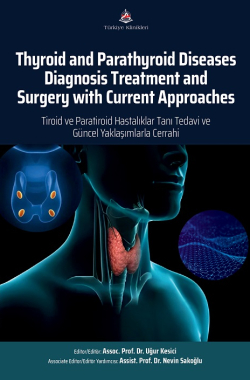ANATOMY AND PHYSIOLOGY OF THYROID AND PARATHYROID GLANDS
Uygar Düzci
Medipol University, Faculty of Medicine, Department of General Surgery, İstanbul, Türkiye
Düzci U. Anatomy and Physiology of Thyroid and Parathyroid Glands. Kesici U, ed. Thyroid and Parathyroid Diseases: Diagnosis, Treatment and Surgery with Current Approaches. 1st ed. Ankara: Türkiye Klinikleri; 2025. p.9-17.
ABSTRACT
The thyroid gland, one of the largest endocrine glands, plays a pivotal role in regulating metabolism, growth, and development. It is situated in the lower anterior neck, in front of the trachea, and consists of two lateral lobes connected by an isthmus. The gland receives its arterial blood supply primarily from the superior and inferior thyroid arteries, while venous drainage is facilitated through the supe- rior, middle, and inferior thyroid veins. The thyroid is anatomically close to the recurrent laryngeal nerve, which has significant implications for surgical procedures.
The thyroid gland produces thyroxine (T4) and triiodothyronine (T3) as its principal hormones. Their synthesis is controlled by the hypothalamic-pituitary-thyroid axis; thyrotropin-releasing hormone (TRH) from the hypothalamus stimulates the release of thyroid-stimulating hormone (TSH) from the pituitary, which subsequently stimulates thyroid hormone production. These hormones regulate cel- lular energy metabolism, oxygen consumption, and protein synthesis. Additionally, the thyroid gland secretes calcitonin, which is involved in calcium homeostasis.
The parathyroid glands, typically four in number, are small endocrine glands located on the posterior surface of the thyroid. However, their number and positioning may vary due to embryological differ- ences. The parathyroids are primarily supplied by the inferior thyroid artery, with venous drainage into the thyroid venous plexus. Given their close anatomical relationship to the thyroid, careful preservation of the parathyroid glands during thyroid surgery is crucial.
The main function of the parathyroid glands is the secretion of parathyroid hormone (PTH), which is essential for regulating calcium and phosphate homeostasis. PTH increases calcium release from bones, enhances renal calcium reabsorption, and stimulates the synthesis of vitamin D (calcitriol), all of which work together to maintain optimal serum calcium levels. Additionally, PTH promotes phos- phate excretion to help preserve calcium-phosphate balance.
Disorders of the thyroid and parathyroid glands can lead to significant systemic effects. Hypothyroid- ism results from insufficient thyroid hormone production, while hyperthyroidism arises from excessive hormone synthesis. Dysfunction of the parathyroid glands can lead to conditions such as hypercalce- mia or hypocalcemia, causing severe metabolic disturbances. A comprehensive understanding of the anatomy and physiology of these glands is fundamental for both clinical and surgical practice.
Keywords: Thyroid gland; Parathyroid glands; Thyroxine (T4); Triiodothyronine (T3); Calcitonin; Parathyroid hormone (PTH); Hypothyroidism; Hyperthyroidism; Calcium metabolism; Hypocalcemia; Hypercalcemia; Endocrine surgery; Serum calcium levels; Metabolic regulation
Kaynak Göster
Referanslar
- Gray H, Standring S. Gray's Anatomy: The Anatomical Basis of Clinical Practice. 42nd Edition. Elsevier, 2020. [Link]
- Boron WF, Boulpaep EL. Medical Physiology: A Cellular and Molecular Approach. 3rd Edition. Elsevier, 2017. [Link]
- Williams TE, Larsen PR, Kronenberg HM, et al. Williams Textbook of Endocrinology. 14th Edition. Elsevier, 2020. [PMC]
- Moore KL, Agur AMR, Dalley AF. Clinically Oriented Anatomy. 8th Edition. Wolters Kluwer, 2018. [Link]
- Hall JE, Guyton AC. Guyton and Hall Textbook of Medical Physiology. 14th Edition. Elsevier, 2020. [Link]
- Melmed S, Polonsky KS, Larsen PR, Kronenberg HM. Endocrinology: Adult and Pediatric. 7th Edition. Elsevier, 2016. [Link]
- Netter FH. Atlas of Human Anatomy. 8th Edition. Elsevier, 2022. [Link]
- Galloway M, Grossman A. Endocrinology in Clinical Practice. Taylor & Francis, 2016. [Link]
- Thyroid Disease Guidelines: American Thyroid Association (ATA) Guidelines for the Diagnosis and Management of Thyroid Disease, 2023. [Link]
- Bilezikian JP, Khan AA, Silverberg SJ. Primary Hyperparathyroidism: New Concepts in Clinical Practice. Endocrine Reviews, 2022. [Link]
- Allgrove J., Shaw N. J. Calcium and Bone Disorders in Children and Adolescents. Endocrine Development, Karger, 2015. [Crossref]
- Rosol TJ, Capen CC. Pathophysiology of Calcium, Phosphorus, and Magnesium Imbalances. Endocrine Reviews, 2016. [Link]
- Michels G, Schedl A. The Role of CaSR in Parathyroid Gland Physiology and Disease. Nature Reviews Endocrinology, 2018. [Link]

